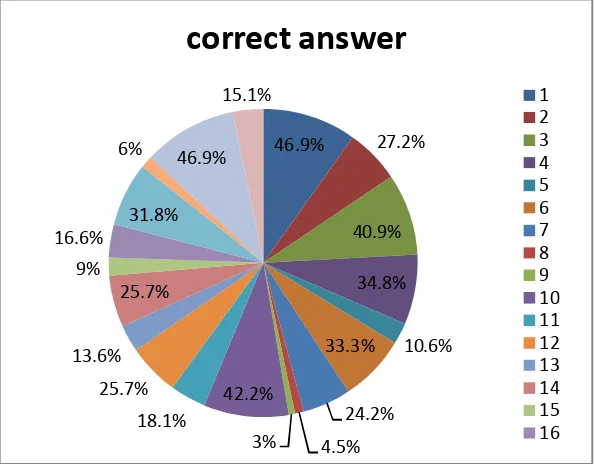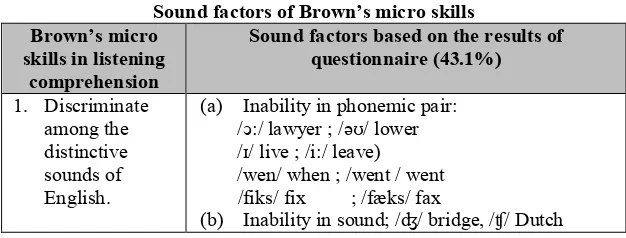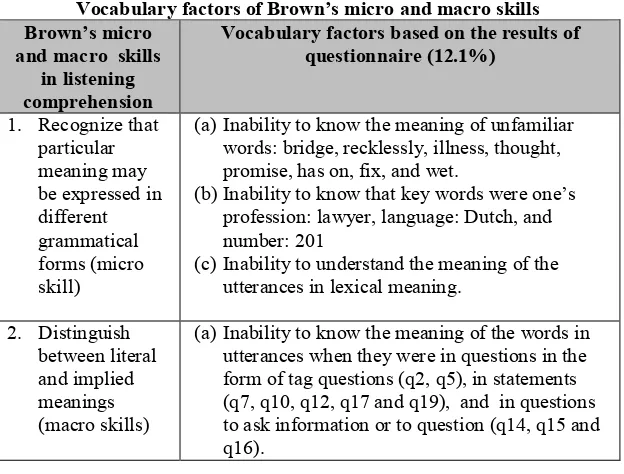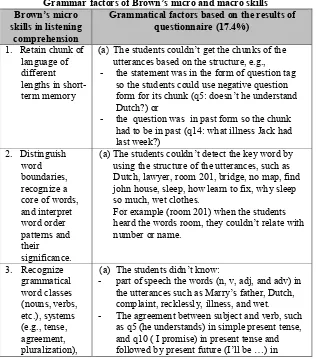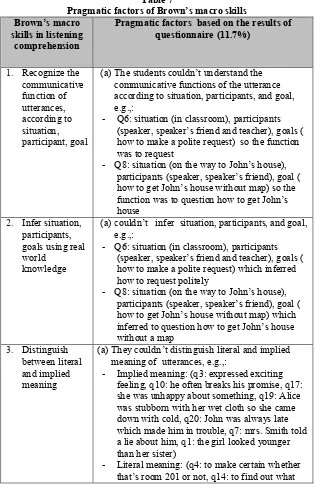THE LISTENING COMPREHENSION OF SMK STUDENTS IN DEMAK
A
AttiikkMMuujjiiRRaahhaayyuu22
Abstract.
Listening is a language skill that assists the students to comprehend spoken language. However, listening is often neglected at schools in Indonesia due to the system of school curriculum in which listening to oral English is the skill least taught at school. As a result, listening becomes a difficult language skill for the students, especially vocational school students. There are many factors that students have to cope with in order to comprehend spoken English. To achieve a certain level of listening comprehension, students have to master micro and macro skills as mentioned in Brown’s taxonomy in listening comprehension.
This study proved that there were four major factors that hindered students’ ability in listening comprehension: sounds, vocabulary, grammatical awareness and pragmatic differences. It was concluded that the main cause of the students’ inability to comprehend spoken language was micro skills, which happened to the students at low level, especially recognition of word sounds. Accordingly, micro skills should be introduced to enrich students’ knowledge of language.
Keywords: listening comprehension, comprehension level, factors hindering comprehension, listening taxonomies
Introduction
Listening is a language skill that assists the students to comprehend spoken language. The students have to be able to receive and to understand incoming information (input) immediately in order to comprehend oral communication easily at various levels. This involves active processes not only what the students hear but also connect it to other information they have already known and combine it with their own ideas or experiences in a-very-real-sense to create meaning. To achieve a certain level of listening comprehension, students have to master knowledge of language as mentioned in Brown’s micro and macro skills taxonomy in listening comprehension. These micro and macro skills cover some factors such as sounds, vocabulary, grammatical awareness, and pragmatic differences. All of these factors are interrelated each other and affect the students to comprehend spoken language.
2 Atik Muji Rahayu aaddaallaahh Mahasiswa S2 MPBI Universitas Katolik Widya Mandala
The importance of listening to comprehend oral communication is undeniable at vocational schools that prepare their outputs to meet the need of work field opportunities both in Indonesia and abroad. However, listening is often neglected at schools in Indonesia due to the system of school curriculum in which listening to oral English is the skill least taught at school. As a result, listening becomes a difficult language skill for the students, especially vocational school students. This condition has been attracted a few researches on listening comprehension in Indonesia, such as Nasrudin (2010 ) and Cahya et al (2008). Nasrudin (2010) investigated strategies of listening comprehension and these strategies succeeded in assisting the students to answer listening comprehension questions test. Cahya et.al (2008) found that listening became a complex activity for students because the teaching of listening in Indonesia was integrated with other English language skills. Cahya et.al (2008) reported that students were good at speaking, reading, and writing but not at listening.
In line with complexity of listening, Buck (2001: 1) defined listening comprehension as a process, a very complex process of making sense of what listeners hear and the listeners first must understand how the process works to measure it. In processing a message, the listeners need a number of different types of knowledge that are involved in comprehension system, namely linguistic and non-linguistic knowledge. Among the most important linguistic knowledge are phonology, lexis, syntax, semantics, and discourse structure which assist listeners to understand meaning through basic linguistic meaning in order to interpret literal meaning based on the context of communication. While non-linguistic knowledge used in comprehension is knowledge about topic, content, and general knowledge about the world and how it works. Those kinds of knowledge facilitate listeners to develop their further language proficiency in the goal of extracting meaning from messages.
deduce cause and effect, and detect such relations as main idea, supporting ideas, generalization and exemplification. Both micro and macro skills occur in bottom up and top down processes that help listeners to comprehend spoken discourse (Richard, 2009). Lyman (1992) presented three features of a successful listener: (1) being able to interpret what has been said which lead to understanding, (2) being able to evaluate the information, and (3) being able to respond to what is heard.
This study is in effort to investigate the students’ listening comprehension ability at a vocational school within the aims to answer the following questions:
1. What are the levels of SMK Demak students’ listening comprehension?
2. What factors hinder the students’ ability in listening comprehension?
Research Methodology
The study was a descriptive case study analyzing a listening comprehension of SMK Demak students. The subject was two classes majoring accounting department by total number around 66 students in grade XI in the second semester of 2013-2014 academic year and taken by purposive sampling for the limited time. To obtain the data needed in this study, a standardized listening comprehension test by Cornelius and Brown (1980) was used to test the subjects. The test consisted of 20 responsive listening comprehension test items in the form of multiple-choice requiring the students’ listening comprehension on both micro and macro skills. The questionnaire was closed – ended questions within all possible and relevant responses used to find out the factors hindered students’ listening comprehension. The scores of listening test administered was used to describe students’ listening comprehension levels. The gain scores were categorized into low, medium, good, and very good which referred to four levels of listening comprehension, namely novice, elementary, intermediate, and advanced.
Table1
Levels of listening comprehension
Levels Categories Gain score
Advanced Very good 16 – 20
Intermediate Good 11 – 15
Elementary Medium 6 – 10
Novice Low 1 – 5
The Findings
Based on the result of the test, most students of SMK Demak were low for their listening comprehension and it reached 71.2%. This level was the same as the novice level at SMK curriculum. While 28.8% of the students were in medium level which similar to elementary level. The following table describes the levels of the students’ listening comprehension.
Table 2
Listening Comprehension Level
Level Score Number of students /
percentages
Medium 6 – 10 19 (28.8 %)
Low 1 – 5 47 (72.2 %)
To strengthen the results of the findings that SMK Demak students were at low level, the writer presented accurate data of students’ correct answers on their listening comprehension test items in the following table.
condition. In addition, two of those sentences was a complex sentence and a question to make a request, “I promise that I’ll be on time” and “I’d like the teacher to slowdown, what should I say?” but in simple forms. Besides, the words were used on those sentences were common in the usage, such as long, promise, on time, older, clothes, teacher, has, complaint and slow down and they were categorized as high-frequency words. Questions number 9 (3%), 8 (4.5%), 18 (6%) and 15 (9%) were the lowest frequency test items which could be answered by the students. Those questions were conditional sentence, simple questions with auxiliary do, simple questions with questions words why. Table 3 reflects that the ability of the subject to comprehend spoken language was poor.
Whereas from the obtained data of questionnaire, some factors caused the difficulties for the SMK students to comprehend listening test items were found and classified into four major categories namely, (1) lack of variety different sounds,(2)vocabulary,(3) grammatical awareness, and (4) Pragmatic differences and the details are as follow:
43.1% of SMK students responded that they had difficulty in listening comprehension due to inability to recognize the sounds of the utterances, namely in words, phrases, or sentences. This covered inability to pronounce the sounds: /ↄ:/, /ʤ/, /Ɵ/, and number in words lawyer, bridge, thoughtand201. They also could not discriminate phonemic pairs in the wordslive /ɪ/ andleave /i:/,leaving /i:/andliving /ɪ/, andlawyer/ↄ:/ andlower /əʊ/ as well. In morphological pair, the students had difficulty to this statement: “He understands Dutch, doesn’t he?”. Besides, they had trouble in silent /l/, /h/ and /r/, e.g.,talking, when, older, learn, apartment, ever, car and etc. Meanwhile, word clusters also became a problem for students to recognize the sound as in those words occurred a phonological modification, for example;ever learn, to fix your car,live alone,has on, your apartment,going out, andfeel like it. They also did not know how to stress and to intonate the words in single words, phrases and sentences, e.g.,I THOUGHT/ all of your RELATIVES/ were in CALIFORNIA.These made the students lose to process speech at different rates of delivery for the speech seemed too fast and sentence in utterances were too long. The result, the students failed to detect major and minor constituents and trapped them in difficulty in getting complete meaning of the message.
Table 4
Sound factors of Brown’s micro skills Brown’s micro
skills in listening comprehension
Sound factors based on the results of questionnaire (43.1%)
1. Discriminate among the distinctive sounds of English.
(a) Inability in phonemic pair: /ↄ:/ lawyer ; /əʊ/ lower /ɪ/ live ; /i:/ leave) /wen/ when ; /went / went /fiks/ fix ; /fæks/ fax
/Ɵ/ thought
(c) Inability in silent l, h, r; /l/ talking and /h/ when, /r/ older, learn, apartment, ever, car (d) Inability to recognize phonological
modification of word clusters; live alone, talking about, going out, has on, feel like it, ever learn, to fix, your car, all of, I’d like, I’ll be on time.
(e) Inability in morphological pair: e.g., Speaker: he understands Dutch, doesn’t he? But the students heard: He understand Dutch, doesn’t he?
(a) Inability in stress pattern: e.g., - Stressed in content words: thought,
relatives and California, etc.
- Unstressed in function words: all, of, your, in, were, I, etc
- intonation: e.g.,
I THOUGHT/ all of your RELATIVES/ were in CALIFORNIA.
(a) Inability to recognize the sounds in: - Contraction: that’s, I’d, I’ll
- Weak forms: article: a, contraction: I’d, I’ll, auxiliaries: do, did, are, preposition: of, to , on, in, for
- Chunks: e.g., a long bridge, is her father a lawyer?, doesn’t he understand Dutch?, etc.
4. Process speech at different rates of delivery
(a) The speech was too fast
(b) The utterances (questions or statements) were too long
not know how to get implied meaning. The implied meaning is presented in detail in pragmatic factors.
As the vocabulary not only deals with the word but it also deals with its meaning and its structure in utterance, so that the writer concludes that students’ ability in vocabulary was low. It was proved by unfamiliarity with the sound of words, although the students knew the meaning they could not detect the key words and their structure in order to get the complete meaning of the utterance.
Table 5
Vocabulary factors of Brown’s micro and macro skills Brown’s micro
and macro skills in listening comprehension
Vocabulary factors based on the results of questionnaire (12.1%)
(a) Inability to know the meaning of unfamiliar words: bridge, recklessly, illness, thought, promise, has on, fix, and wet.
(b) Inability to know that key words were one’s profession: lawyer, language: Dutch, and number: 201
(c) Inability to understand the meaning of the utterances in lexical meaning.
(a) Inability to know the meaning of the words in utterances when they were in questions in the form of tag questions (q2, q5), in statements (q7, q10, q12, q17 and q19), and in questions to ask information or to question (q14, q15 and q16).
using the structure of the utterances, e.g., room 201, when the students heard the word “room” they had to relate with number or name.
In this macro skills of grammar, most students could not develop strategies how to detect the key words or to guess meaning from the context by using their grammatical knowledge, although they got listening practices in paragraph and dialogue in conversation. The last, they were unable to infer the utterances based on the situation, participants, and speaker’s goal which these were usually used in analyzing the paragraph and dialogue in conversation. For instance, question number 6:situationwas in classroom,participantswere speaker, speaker’s friend and teacher, andthe goals: how to make a polite request which required students to understand request and to make request in appropriate linguistic form. It means grammatical knowledge was needed by students to make such a request.
Table 6
Grammar factors of Brown’s micro and macro skills Brown’s micro
skills in listening comprehension
Grammatical factors based on the results of questionnaire (17.4%)
(a) The students couldn’t get the chunks of the utterances based on the structure, e.g., - the statement was in the form of question tag
so the students could use negative question form for its chunk (q5: doesn’t he understand Dutch?) or
- the question was in past form so the chunk had to be in past (q14: what illness Jack had last week?)
(a) The students couldn’t detect the key word by using the structure of the utterances, such as Dutch, lawyer, room 201, bridge, no map, find john house, sleep, how learn to fix, why sleep so much, wet clothes.
For example (room 201) when the students heard the words room, they couldn’t relate with number or name.
(a) The students didn’t know:
- part of speech the words (n, v, adj, and adv) in the utterances such as Marry’s father, Dutch, complaint, recklessly, illness, and wet. - The agreement between subject and verb, such
patterns, rules,
(a) Inability to recognize major and minor constituent, e.g. I promise something ( major) and I’ll be on time (minor)
5. Recognize cohesive devices in spoken discourse.
(a) Inability to recognize cohesive devices , when the students heard the words going out and don’t feel like it so they had to know there was contradiction or concession and its relative word.
Brown’s macro skills in listening
comprehension
Grammatical factors based on the results of questionnaire and interview (7.2%)
(a) The students could not develop strategies to detect key words such as (q6:slow down and what … say) and guess the meaning of words from this context (asking how to ask the teacher to slow down) and appealing for help and signal comprehension (I’d like and should)
2. Couldn’t infer
(a) Inability to understand meaning of comparative sentence that there were participants compared; you and your sister
(b) The students couldn’t infer situation (e.g., q8:in classroom), participants (speaker, speaker’s friend and teacher), goals ( how to make a polite request) using real world knowledge
utterances such asto question: q6 and q8,to ask information: q4, and q9 or to promise q10. In addition, the students could not distinguish literal and implied meanings such as q14, q16, q17, and q20. Thus, context is crucial for the students to comprehend spoken language.
Table 7
Pragmatic factors of Brown’s macro skills Brown’s macro
skills in listening comprehension
Pragmatic factors based on the results of questionnaire (11.7%)
(a) The students couldn’t understand the communicative functions of the utterance according to situation, participants, and goal, e.g.,:
- Q6: situation (in classroom), participants (speaker, speaker’s friend and teacher), goals ( how to make a polite request) so the function was to request
- Q8: situation (on the way to John’s house), participants (speaker, speaker’s friend), goal ( how to get John’s house without map) so the function was to question how to get John’s house
(a) couldn’t infer situation, participants, and goal, e.g.,:
- Q6: situation (in classroom), participants (speaker, speaker’s friend and teacher), goals ( how to make a polite request) which inferred how to request politely
- Q8: situation (on the way to John’s house), participants (speaker, speaker’s friend), goal ( how to get John’s house without map) which inferred to question how to get John’s house without a map
3. Distinguish between literal and implied meaning
(a) They couldn’t distinguish literal and implied meaning of utterances, e.g.,:
- Implied meaning: (q3: expressed exciting feeling, q10: he often breaks his promise, q17: she was unhappy about something, q19: Alice was stubborn with her wet cloth so she came down with cold, q20: John was always late which made him in trouble, q7: mrs. Smith told a lie about him, q1: the girl looked younger than her sister)
illness jack had last week, q15 n 16: ask his reason on his going out and ask the way learn to fix car)
Discussion
To be good in listening, the listeners needs to master some knowledge and skills to comprehend spoken language. When listeners’ knowledge and skills is not ample, they will have difficulty to comprehend speaker’s message. As mentioned in findings, SMK students’ listening comprehension test showed that they were in low level and this level was not suitable for grade XI students. In that grade, they had to achieve medium level as mentioned in SMK curriculum, however, the only 28.8 % of them achieved medium level and the rest 71.2 % of them had lower ability. Their low abilities in listening skill also was proved by few words that students caught and understood while they were listening to the test items. Just few students could understand in phrases and rare of them could comprehend in sentences. Besides, minimum correct answers which they could do each listening comprehension test item was less than 50%. All test items were in sentences that helpful to the low-level listeners, however the students still had difficulty to answer.
Lund (1991) stated that lower level listeners benefit from hearing listening item test in the form of words, phrases or sentences which help them in achieving better comprehension. In classroom listening practices and exercises, passage forms and long conversational dialogues were given, however when the subjects was given listening test in sentences, their abilities in listening were poor. These phenomena show the subjects lacked of some knowledge and skills in three areas of grammatical knowledge namely, knowledge of phonology, knowledge of vocabulary, and knowledge of syntax (Bachman & Palmer, 1996). These knowledge made students lose in processing automaticity to recognize acoustic signal modified by speaker depended on regular and rule governed of phonological set and to detect major and minor constituents to get the chunks in relation to the structure and meaning of the text.
In line with first factor of listening comprehension, micro skill factors hindered the students of SMK Demak to recognize the sound in the utterances. These factors cover inability to pronounce the sounds /ʤ/ , /ʧ/, and/ Ɵ/, to differentiate phonemic pairs: /ↄ:/ and /əʊ/, /ɪ/ and /i:/, /wen/and /went/, and /fiks/ and /fæks/, to recognize silent /l/, /h/, /r/, to catch the sound in word cluster, and to recognize the sounds when the words were uttered in correct stress and intonation. This happened as in students’ native language, “Indonesian” there was no sounds /ʤ/ , /ʧ/,
indistinct when speakers modify the sounds make all the phonemes unclear and unambiguous encoded in message”. These modifications are influenced by stress, intonation, linking, assimilation, elision, and word clusters. The reduced forms, “weak form or unstressed words” made the students of SMK Demak had difficulty in recognizing the words, phrases and sentences in the utterances.
Article, preposition, pronouns, auxiliaries and contraction are types of weak forms or unstressed words which also threatened the student in comprehending the listening test. The article, preposition, pronouns, auxiliaries and contraction are called as function words which the students couldn’t ignore their roles to assist them in comprehending listening test. Although those weak forms were not as crucial as the key words and the stressed words in utterances, they also had important role to relate and to connect the key words and stressed words to create a complete meaning as the purpose of speakers. In addition, intonation also affected a lot in processing the speech at different rate of delivery for grasping the correct meaning of the utterance. In fact, the students had never learnt how to pronounce the words, how to stress them when they were joined together in sentences, and how to utter them in good intonation to make the literal and applied meanings clear in the utterances. Furthermore, Cruttenden (1977) mentioned that stress pattern in words and sentences relatively emphasized and formed a very important part of phonological shaped of the words and the words with utterance that indicated speaker’s message. As the students SMK Demak had no basic concept about English phonetics, so it was quite difficult for them to identify suprasegmentals which exacerbated their listening difficulties.
In connection with second factors, vocabulary, words are the basic building blocks of language and the units meaning of larger structures (e.g., sentences, paragraphs, and whole texts) are formed (Read, 2000). To understand the words, the students had to be able to recognize the word and later, had to be able to understand its meaning. The subjects had a low level in listening comprehension as they got the meaning of utterances from the sounds of words that they could recognize. In their responses, the mentioned that they know most words in test items, but they could not recognize the words and key words in the utterances when they were uttered by the speakers. Henning (1973) strengthened that learners at a low level of language learning store vocabulary according to the sounds of words, whereas at more advanced levels words are stored according to meaning.
speaker’s message, and made the students failed to get the message. Sun (2000) mentioned if listeners lack of syntactic knowledge, they may have trouble segmenting streams of speech with many words linked together. Linguistic process assists the students not only to understand sentence but also larger linguistic unit which cover the rules and conventions use in discourse comprehension. When the subjects lacked this process, they got trouble in their listening comprehension and were unable to use and develop strategy for detecting key words of the utterances and guess the meaning. Based on Brown’s taxonomy, the obstacle of students’ ability in listening comprehension was categorized lexico-grammar, knowledge of words and grammatical structure, which cover lexical form, meaning, and syntactic form. As SMK students lacked this, they had a little information to create meaning and the meaning of the utterances became incomplete.
The last factor,Pragmatic,Gimson (1980) stated that meaning is influenced by the emotional attitude of the speaker and Buck (2001) added that the effect of context works through spreading activation into a complex semantic network. The subjects responded that they lacked recognition on various formality levels which were essential variable to understand the speaker’s intention and the effect of utterances to get correct meaning. To understand the meaning correctly in context, the subjects had to point to speaker’s attention in numbers of ways; by announcing the intent e.g., q6: I request the teacher to slow down, by using appropriate syntax e.g., q6: slow down a little, and by indirect speech act e.g., q6:would you please slow down a little?. To get speaker’s intention, the students had to use context to interpret the intent of a message making the meaning clear as it was not always stated explicitly.
Conclusion
The study reveals that students’ listening comprehension of SMK Demak tended to be low as most of the students were in low level which reached 71.2%. This level was far from the school target that XI grade students at least had to achieve elementary level. Their poor abilities in comprehending spoken language were also reflected on their correct answers in their listening comprehension test that they could answer each test item less than 50%. Several test items, such as question number 8, 9, 15 and 18 could be answered by the subject lest than 10%, although they were simple questions. Most probably this was caused by the fact that the subject did not have ample grammatical knowledge, namely knowledge of vocabulary, syntax and phonology.
comprehension. This happened as in subjects’ native language , “Indonesian”, there are no sounds: /ʤ/ , /ʧ/, /Ɵ/, /ↄ:/ and /əʊ/, no differentiation in pronouncing the sound /ɪ/ and /i:/, and the sounds /l/, /h/, and /r/ are pronounced clearly in Indonesian. The way how to stress and intonate the words in utterance are also different between Indonesian and English. In vocabulary, the students had difficulties to understand the meaning of single words, such as bridge,recklessly,illness,has on, fix,Dutch,andwet. Although they understand the meaning most words in utterances, the subjects could not recognize them while uttering by native speakers.
The students’ grammatical knowledge was insufficient which distracted them to constrain the syntactic structure of upcoming input. This made the students fail to get chunks, grammatical word classes, and constituents in using and developing strategy to detect key words and guess the meaning of message. Lack of syntactic knowledge made the students enable to segment streams of speech with many words linked together and could not assist the students to understand sentence in larger units. While, in pragmatics, the students had more difficulties to understand the meaning of the utterances in context base on the speaker’s purpose.
In short, there are many factors that students have to cope with, in order to comprehend spoken language. To achieve a certain level of listening comprehension, they have to master micro skills, especially sound factors. The students need a lot of exposure to real native speaker conversation and to be trained in micro skills to improve their abilities in listening. However, macro skills also became a factor that could not be neglected in listening skill and these skills have to be taught after the students have mastered micro skills. To conduct it, the teacher should create conducive atmosphere in teaching and be able to create meaningful learning for the students.
Bibliography
Anderson, A. and Lynch, T. 1988.Listening. Oxford: Oxford University Press.
Ary, D. 2010. Introduction to Research in Education. Belmont USA: Wadsworth Cengage Learning.
Brown, J. D. and Cornelius, E. 1976. New English Course. USA: ELS Publications.
Brown, G. 1996.Listening to Spoken English (2nd ed.).USA: Longman.
Brown. D.H. 2004. Language assessment: Principle and Classroom Practices. USA: Longman.
Bryne, D. 1978.Listening Comprehension Practice. USA : Longman.
Buck, G. 1988. Testing Listening Comprehension in Japanese University Entrance Examination. JALT Journal, 10 (1), 15-42.
Buck, G. 1991.The Testing of Listening Comprehension: An introspective study: Language testing, 8 (1), 67-91.
Buck, G. 2001.Assessing Listening. UK:Cambridge University Press.
Cahyono, B. Y. 2010. The Teaching of English Language Skills and English Language Components. Malang: State University of Malang Press.
Carrol, B. J. and West, R. 1989.ESU Framework: Longman Group.
Dupuy, B. 1999. Narrow Listening: An Alternative Way to Develop Listening Comprehension in the Foreign Language Classroom. System 24, 1: 97 – 100.
Goh, C. 2000.A Cognitive Perspective on Language Learners’ Listening Comprehension Problems.System 28, 1: 55-75.
Henning, G. 1987. A Guide to Language Testing: Heinle & Heinle Publisher.
Krashen, S.D. 1981. The Fundamental Pedagogical Principle in Second Language Teaching.Studia Linguistica 35, 1-2: 50-70.
Krashen, S.D. 1985. The Input Hypothesis: Issues and Implications. London: Longman.
McMillan, J. H. 2008.Educational Research.USA: Pearson.
Nasrudin, W. 2008.Preparing Students to Face Listening Comprehension Tests. State College for Islamic Studies. Malang: State University of Malang Press.
Newtown, J. 2009.Teacing ESL/EFL Listening and Speaking. New York: Routledge.
Nunan, D. 1998. Approaches to Teaching Listening in English Classroom.Korea: Korea TESOL Conference.
Nunan, D. 2003. English Language Teaching.USA: Longman.
Pollack, I. and Pickett, J. 1963. Intellgibility of Excerpts from Fluent Speech: Effect of Rate Utterance and Duration. Language and Speech, 6: 151-164.
Richards, J. C. 1983.Listening Comprehension.TESOL Quarterly17: 2
Tsui, A. and Fullilove, J. 1998. Bottom-Up and Top-Down Processing as a discriminator of L2 Listening Performance. Applied linguistics 19, 4: 432-451.
